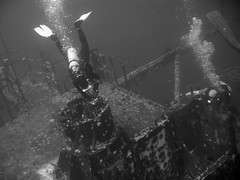 Image by divemasterking2000 via Flickr
Image by divemasterking2000 via Flickr
Follow the Law
The first precaution you should always take before wreck diving is making sure that you understand the laws surrounding diving near or at a particular wreck site. Some wrecks are protected by laws and you are not permitted to legally dive there without the right permit or permission. Some wreck sites are specifically designated to be sites of interest and these are historic places that are protected by the law. You also need to understand the salvage law as it pertains to the wrecks you will be diving and how artifacts gathered should be handled.
Diving Safely Around Historic Wrecks
Not only do you need to observe safety measures to protect yourself when wreck diving, but you also need to take safety measure to protect the wreck itself so that it is not destroyed or damaged by your diving. Using a dive table is an essential part of diving wrecks and will tell you the correct length of the dive according to the current water depth.
Another safety aspect to keep in mind when wreck diving is the amount of silt and rust particles that can be in the water surrounding a wreck site and that can affect your visibility in the water. Proper training can help you learn how to maneuver through this situation safely.
Other important things to keep in mind safety wise while you dive a wreck. Are the possible loose sections of the wreck that you could run into, sharp edges that you can get caught on and also possibly becoming trapped in the unstable wreckage. If you decide to dive a wreck, it is especially important that you always go with at least a buddy if not in a group.
Things you should consider bringing with you on a wreck dive include a good underwater light or lamp and a knife. The best precaution to take when wreck diving is to remember to look around and be aware of your surroundings at all times, but not to touch anything. This will still allow you to experience the thrill of diving a historic wreck without the danger or structural damage that touching and moving the wreckage could cause.
If you are considering taking up wreck diving, then there are a lot of precautions and legal guidelines you need to understand before undergoing your first dive. Even after you understand all safety precautions; it is still a good idea to gain some additional training in diving wrecks to be better prepared for all possible aspects of this type of dive.
thanks to DiveTime for this article
Kathy Dowsett
www.kirkscubagear.com

No comments:
Post a Comment